Season 22
Teams racing around the globe this year include a pair of roller derby moms, country singers, hockey brothers, YouTube hosts, firefighters and twin OB/GYNs.
This season, which marks the 22nd race around the world for the series, will introduce a new twist to the game in which the first Team to check in at the first pit stop will earn two "Express Passes" - one to keep for themselves and one that must be given to another Team by the end of the fourth leg of the Race.
Teams will travel more than 30,000 miles, over five continents and through nine countries as they skydive from 10,000 feet in Bora Bora, participate in a Shemozzle race in New Zealand, hunt for scorpions with the Bushmen of Botswana and scale the treacherous north face of the Eiger Mountain in Switzerland.
This season's diverse cast includes twin brothers who are both OB/GYNs, father/son cancer survivors, Southern firefighters, roller derby moms and female country singers.
Jerry Bruckheimer, Bertram van Munster, Jonathan Littman, Elise Doganieri and Mark Vertullo are the executive producers for Jerry Bruckheimer Television and Earthview Inc. in association with ABC Studios and Amazing Race Productions.
Season 22 Teams
Idries Abdur-Rahman and Jamil Abdur-Rahman
Twin Doctors
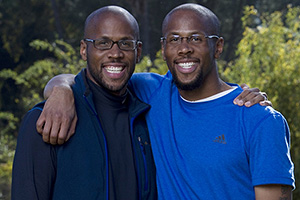
Idries and Jamil are both 36-year-old OB/GYN physicians from Chicago, Illinois.
Max Bichler and Katie Bichler
Newlyweds
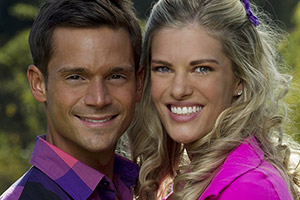
Max is a 30-year-old cigar salesman, and Katie is a 24-year-old pharmacist. They are both from Buffalo, New York.
Mona Egender and Beth Bandimere
Roller Derby Moms
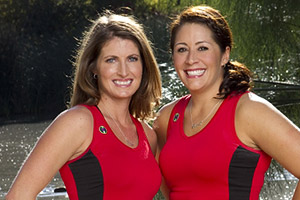
Mona is a 33-year-old captioner and Roller Derby player from Castle Pines, Colorado. Beth is a 36-year-old Roller Derby player who's in technical support from Arvada, Colorado.
Bates Battaglia and Anthony Battaglia
Hockey Brothers
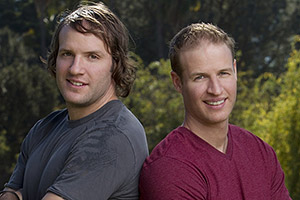
Bates is a 36-year-old former professional hockey player - who played for the NHL's Carolina Hurricanes, Colorado Avalanche, Washington Capitals, and Toronto Maple Leafs - and Anthony is a 33-year-old professional hockey player, who currently plays for the Huntsville Havoc. They are both from Raleigh, North Carolina.
Chuck McCall and Wynona McCall
Married Couple
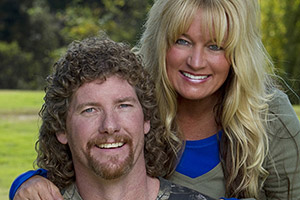
Chuck is a 46-year-old retail manager and taxidermist. Wynona is a 49-year-old cosmetologist and hairstylist. They are both from Daphne, Alabama.
David O'Leary and Connor O'Leary
Father and Son
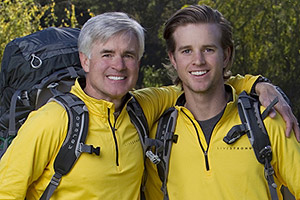
David is a 58-year-old in investment properties, and Connor is a 21-year-old professional cyclist. They are both from Salt Lake City, Utah.
Caroline Cutbirth and Jennifer Kuhle
Friends and Country Singers
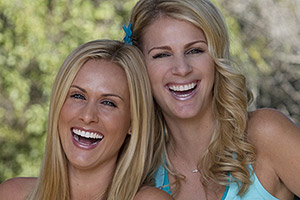
Caroline is a 29-year-old singer and songwriter, who's a direct descendant of Daniel Boone, from Austin, Texas. Jennifer is a 30-year-old songwriter, who's the granddaughter of John Wayne, from Nashville, Tennessee. They are both band members of the group "Stealing Angels."
Joey Graceffa and Meghan Camarena
Friends and YouTube Hosts
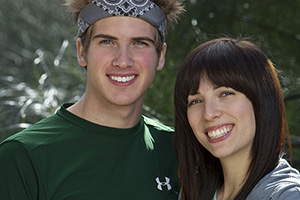
Joey is 21-years-old and Meghan is 25-years-old. They are both Internet personalities and YouTube hosts of their own YouTube channels from Los Angeles, California.
Pamela Chien and Winnie Sung
Best Friends
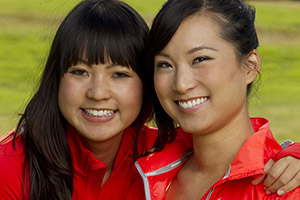
Pamela is an art director and fitness instructor, and Winnie is a senior project manager. They are both 29-years-old and from Los Angeles, California.
Jessica Hoel and John Erck
Dating Couple
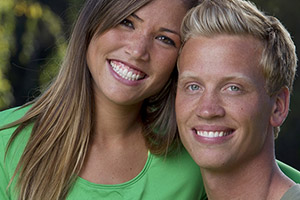
Jessica is a 26-year-old account manager, and John is a 27-year-old entrepreneur and computer programmer. They are both from Huntington Beach, California.
Matthew Davis and Daniel Moss
Best Friends and Firefighters
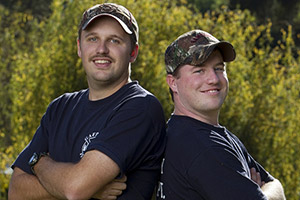
Matthew is 25-years-old and Daniel is 24-years-old. They are both firefighters from Gaffney, South Carolina.
About the Show
The Amazing Race is a reality competition that follows teams of two people each (four in Season 8) that are pitted against each other in a 30- to 40-day journey through diverse cities and countries around the globe. The first team to reach the final destination will be rewarded with $1-million.
Without cellphones and carrying only limited cash, the two-person team must perform mentally challenging and physically grueling tasks at every stop before they can move on to the next destination.
Those who can’t keep up with the quick pace will be eliminated from the competition. The team to make it back first with the tasks completed wins the global game of the century.
The teams are filmed non-stop, chronicling their journey as well as the conflicts and deepening relationship that may develop through the competition.
Each team will have a strict budget and has to rely on wit and ingenuity – perhaps even sleeping on park benches, or in bus stations to conserve limited funds.
The contestants rely on transportation by bus, train, boats, taxis, bicycles, elephants and even camels to get to their destinations, but only one team can win the coveted prize of a million dollars.
Concept
The original idea for The Amazing Race began as a bet between current producers Elise Doganieri and Bertram van Munster, with van Munster challenging Doganieri to develop a concept for a TV show in less than five minutes while both were attending a trade convention.
With Doganieri's suggestion of a race around the world, the two refined the concept and sold it to CBS.
Format
The present form of The Amazing Race, for the most part, has not changed from the first season. The race utilizes progressive elimination: the last team to arrive at a designated checkpoint (Pit Stop) leaves the game.
The race starts in a US city. Teams must then follow clues and instructions and make their way to checkpoints in places around the world, eventually racing back to the finish line in the US.
Along the way they perform tasks that represent the culture of the present country or city.
Tasks include Detours (an option between two tasks of various difficulty) and Roadblocks (a task that can be done by only one member of a team); additionally, other optional markers, if reached first, can provide a team with a Fast Forward (allowing a team to skip remaining tasks and go to the checkpoint), a Yield (the ability to delay another team for a short amount of time) or a U-Turn (the ability to force another team to do the other detour they didn't choose).
Teams race with limited possessions and are given a fixed amount of money for all travel purposes save for airline tickets, which are paid for by production-issued credit cards.
Production
The production of The Amazing Race is an extremely difficult aspect, given that unlike other reality TV shows, the show continues to move about the world all the time.
Despite such difficulties, the show has been nominated twenty times for Primetime Emmy Awards, winning ten times.
Pre-race
Production will scope out several locations for the race and will send people to investigate potential tasks and activities to be performed in the tasks. Production also must work with the local governments to acquire filming rights and allowances for the race.
Most of the tasks are attempted by production to determine the difficulty and timing with each task as well as to determine how to shoot that task.
Teams are selected through a multi-step interview process, usually starting with country-wide interviews at a few major cities. Once teams have been selected, teams are given a list of countries that they will need to apply for visas for.
To avoid spoiling too much of the race, this list includes more countries than are planned to be visited, so that teams cannot plan on where they will be visiting.
For clothing, teams are generally asked to plan for coordinating clothes, at least in the first few legs, to help with team identity and differentiation.
Some teams have taken it upon themselves to procure custom clothes with their personal team moniker or names (examples include Joe & Bill from Season 1, Ken & Gerard and Aaron & Arianne from Season 3, Marshall & Lance and Linda & Karen from Season 5, Joseph & Monica from Season 9, and Erwin & Godwin from Season 10), though these are not required.
A few days before the race, teams and last minute replacements are flown into the same city (usually not the same as the actual start city) and sequestered in a hotel.
Teams are asked to prepare their bags for the race, and production verifies the contents, removing any items prohibited by the race. On the day before or the day of the race, teams are then flown to the actual starting city and to the start line.
Prior to actually starting the race, teams are asked to take off by foot from the starting line several times in order to get several shots of the teams both in close-up and while racing away.
During the race
Each team is accompanied by a two-person camera crew (camera operator/sound mixer), who must stay with the team at all times, except at Pit Stops and during certain Detours or Roadblocks. The crews rotate between teams at Pit Stops to avoid any possible favouritism that may develop between a team and its crew.
The camera crew must be able to ride with the team when they take transportation such as cabs or planes.
Even though the program shows teams asking for only two tickets, they actually have to purchase four tickets to account for the camera crew; what usually happens is that teams first ask the agents for four tickets, and then the camera crew re-shoots the request, this time only asking for two.
Similarly, the camera crew will often ask teams to redo certain actions during a leg in order to get a better camera angle (such as getting into and out of taxis), or to adjust the wireless microphones that each team member is wearing.
These events can lead to "production difficulties", which are usually credited to the team when they reach the Pit Stop.
Many Detours and Roadblocks use special cameras to get more dramatic shots of the racers as they complete the task, such as helmet-mounted cameras for climbing, rappelling, and sky-diving stunts.
The producers may also use helicopters and high overhead cranes to get wide-area camera footage when appropriate.
There are also special camera crews known as 'Zone' cameras that are used near clue boxes, Detours, and Roadblocks, which take over for the team's assigned camera crew in order to get more dramatic shots.
If a team should engage with a non-Race participant, they will need to have the camera crew get the consent of that person to be used on camera via agreement forms. Footage of people that have not consented is either not used, or is used with the person's face pixelized out.
The production team tends to arrive in a country a day or a half-day before the racers themselves arrive; however, there have been times that the lead production crew, including Phil Keoghan, has flown along with the racers into that country.
While the teams are racing, production sets up shots of Phil describing the various tasks, and then prepares for the arrival at the Pit Stop. In a few cases, production had barely arrived just before the teams started to arrive at the Pit Stop.
While in a country, the various production crews keep apprised of the status of each team in order to prepare the location for the arrivals. For example, clue boxes are only set up minutes before the first team arrives to prevent non-racers from getting involved or stealing clues.
Additionally, any obvious penalties or missed tasks are relayed to the Pit Stop crew so that Phil can inform teams appropriately of these.
Once teams have arrived at the Pit Stop, production checks with each camera crew to identify if any additional penalties or time credits are necessary.
When teams check in, they are usually requested to move to the lodging area for the Pit Stop, though during Season 1 this usually did not occur, as teams can be seen hanging around the Pit Stop to greet the other teams as they arrived.
The eliminated team usually gets a chance to say goodbye to the remaining racers. Teams eliminated early in the race are then flown to a common location known as "Sequesterville" where teams are allowed to relax and sight-see (though with restrictions), until they are then flown to the final city for the very end of the Race.
The 4th, 5th, and 6th place teams do not necessarily go to Sequesterville; instead, they may either accompany production through the last few legs and meet up with the rest of the eliminated teams at the finish line (in order to cut down on travel costs), or they may be asked to perform "decoy runs", usually flying into the final city or a different city with a camera crew, a day or so before the final three teams arrive, in order to throw off potential spoilers for the final teams.
The finish line is usually located in an isolated spot, and planned so that teams will arrive mid-day during a weekday, or early on a Saturday or Sunday, in order to reduce the amount of potential sightings of the final teams.
Post-race
All teams are compensated for the time missed from their jobs, though the amount is undisclosed and confidential.
As with most reality TV shows, teams are not allowed to reveal their performance on the race until the episode with their elimination has aired (or, in the case of the final three teams, until after the season finale).
Even after their elimination episode has aired, teams are not allowed to reveal any events, eliminations, or the ultimate winners of the race.
In the past, eliminated teams have typically been asked to appear for an interview on The Early Show on CBS on the day after the airing of their elimination episode, though this practice has been hit-or-miss in later seasons.
Each episode is worked on by a separate team of editors as soon as the race starts; as such, there are usually no "story arcs" unless they develop naturally over the course of the season (for example, the dislike of most of the teams in Season 1 towards Joe and Bill, or the so-called Six Pack/Backpack alliance in Season 10).
Complete tasks have been known to be cut from an episode, usually due to the lack of impact on race standings for that task.
Roadblocks are most commonly edited out should teams depart in the same order as they arrive, though evidence for these Roadblocks can be found from footage still shown, interviews with racers, or from spoiler information.
The opening credits for the first season used a combination of pictures of locations in the race and teams, both posing as well as performing tasks during the race. However, many fans were able to identify the elimination order simply based on these task shots.
Since then, the introduction sequence has used only a combination of location shots from both the current race as well as past races, and only teams posing at their residence or home city, reducing the amount of spoiler content within the introduction.
In two instances of the race, a natural disaster occurred in an area after the race was filmed going through it, but prior to the first episode of the season airing; specifically the 2004 tsunami which struck Sri Lanka during Season 6, and Hurricane Katrina which struck New Orleans during Season 8.
In the latter case, one of the teams racing, the Schroeder family, lost their home in the disaster.
In both cases, the episodes which included race legs within these areas were preceded by a message, read by Phil, which addressed the situation and expressed solidarity with the people in the affected regions.
Glossary
Detour
A choice between two different ways to accomplish a goal or reach a destination. On the surface, one may seem easy but involves some sort of twist; the other may seem difficult but in the end may be the quicker choice.
Pitstop
The final destination for each leg of the Race, at which point a Team must clock in. The last Team to arrive at most Pitstops is eliminated from the Race. A Team will leave the Pit Stop 12 hours after they clock in. For instance, a Team that clocks in at 9am will leave at 9pm.
Fast Forward
Two pre-determined legs have one Fast Forward, which allows the Team that completes the Fast Forward task first to proceed directly to the next Pitstop without having to do any further tasks, including Detours or Roadblocks on the way.
The trick is that only the first Team to find and complete the Fast Forward on the leg may use it; any subsequent Team that finds it will have wasted their time and must go back and complete all tasks.
In addition, a Team may claim only one Fast Forward during the entire Race.
Roadblock
A task in which only one member of the two-person Team may participate. In most cases, the non-participant must wait for the participant to accomplish the goal.
Route Marker
Yellow and white flag that marks the locations of further instructions.
Yield
Each leg of the Race has a Yield point. Teams must stop at the Yield location to do two things before continuing along the course: 1) They must check to see if they have been Yielded by another Team; 2) If no Team has been Yielded, they must decide whether to use the Yield or not.
If a Team is Yielded, they must turn over the hourglass and wait until all the sand runs out before they may continue with the Race.
A Team may use the Yield to stop another Team only once throughout the entire course of the Race. However, there is no limit to the number of times that a Team can be Yielded by the other Teams.